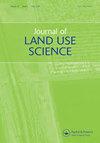Effects of Quality Coffee Production by Smallholders on Local Land Use and Land Cover in Yirgacheffe, Southern Ethiopia
IF 3.3
4区 环境科学与生态学
Q1 AGRICULTURE, MULTIDISCIPLINARY
引用次数: 3
Abstract
ABSTRACT The objectives of the study are to identify LULC types that have undergone changes due to quality coffee production and assess smallholders’ perceptions of the LULC changes associated with their coffee production practices in Yirgacheffe coffee area, southern Ethiopia. The study used Landsat satellite images of 1988, 2003, and 2018 to examine the LULC change. In addition, household surveys and focus group discussions were carried out to assess land management practices in the study area. The findings show that forest coffee (FC) cover decreased at a rate of 1.02% per year in the 30-year time, which was mostly changed to semi-forest and semi-plantation coffee cover. The study area has also experienced an increase in semi-plantation cover (0.07% per year), semi-forest coffee (0.9% per year) over the study period, showing a gradual decrease in vegetation cover. This also suggests that a major driving force for the local LULC change is the increasing demand for coffee in the global and national market, as evident from the increasing trend of coffee export from Ethiopia. Survey data show that quality coffee production drives coffee agroforest conversion while it has potitive effects on land management practices by smallholders. Reducing the current heavy dependence of livelihoods on coffee as the single most important commodity is likely to enhance sustainability of the coffee agroforests in the area.埃塞俄比亚南部Yirgacheffe小农优质咖啡生产对当地土地利用和土地覆盖的影响
本研究的目的是确定由于优质咖啡生产而发生变化的LULC类型,并评估埃塞俄比亚南部Yirgacheffe咖啡区小农对与其咖啡生产实践相关的LULC变化的看法。该研究使用了1988年、2003年和2018年的陆地卫星图像来检查LULC的变化。此外,还进行了住户调查和焦点小组讨论,以评估研究地区的土地管理做法。结果表明:30年间,森林咖啡覆盖面积以每年1.02%的速度减少,主要为半森林和半人工林咖啡覆盖;在研究期间,研究区半人工林和半森林咖啡的覆盖面积分别增加了0.07% /年和0.9% /年,植被覆盖逐渐减少。这也表明,当地LULC变化的主要驱动力是全球和国内市场对咖啡的需求不断增加,这一点从埃塞俄比亚咖啡出口的增长趋势中可以看出。调查数据显示,优质咖啡生产推动咖啡农林复合转型,同时对小农的土地管理实践产生积极影响。减少目前生计对咖啡这一最重要商品的严重依赖,可能会提高该地区咖啡农林复合林的可持续性。
本文章由计算机程序翻译,如有差异,请以英文原文为准。
求助全文
约1分钟内获得全文
求助全文
来源期刊

Journal of Land Use Science
Environmental Science-Management, Monitoring, Policy and Law
CiteScore
5.40
自引率
6.20%
发文量
26
期刊介绍:
The Journal of Land Use Science provides a central outlet for high-quality articles on theoretical and empirical aspects of land-use science at the interface of social and environmental systems. The Journal brings together an array of research perspectives at multiple temporal, spatial and social scales that contribute a better understanding of land-system dynamics and communicate scientific advances towards attaining land-system sustainability.
 求助内容:
求助内容: 应助结果提醒方式:
应助结果提醒方式:


